Why do you do what you do? Why do you feel motivated to do some things, but not others? How does your environment, experiences and personality impact your motivation? Can you change your motivation and alter the direction of your life?

Motivation matters. But it’s also mysterious. We all know what it feels like to be driven to act, but we don’t always know why we feel that way.
There’s considerable research on motivation, but getting the gist of it isn’t easy. Consider Wikipedia’s entry on motivation, which includes over 20 different theories! Given the diversity, it’s no wonder people gravitate to memorable-but-discredited ideas such as the fanciful interpretations of Freud.
In an earlier essay, I asked why taking action is hard. Why do so many of our life problems seem to stem from an inability to motivate ourselves to do what we should? To sate that curiosity, I read through dozens of papers and books to see what science has discovered so far. This guide is my attempt to summarize the most important and useful research in the science of motivation.
Side note: This guide, like the other Complete Guides, is long. More like a small book than a blog post. If you’d like to listen to it as a podcast (~90 minutes) or read it as a PDF or eReader, just join our newsletter and I’ll send you the links:
Now let’s dive in to understand what makes you tick…
Table of Contents
The History of Motivation
William James: Volition and Habit

To understand motivation, it helps to see how views have shifted over time.
William James spurred much of modern thinking in psychology.1 It’s rare to find a topic of importance about human minds where James didn’t anticipate at least some of the developments of the field. Motivation is no exception.
James thought of volition as creating a cascade of habitual behaviors. One action created the stimulus for the next, and so complex behaviors were seen as a row of dominoes. Only the initial act was conscious, and often conceived in terms of the likely outcome at the end of the sequence.

But what about the first action, before habits took over? James argued that our wills were impulsive. Action flowed, “unhestitatingly and immediately the notion of it in the mind.”2 He vividly describes the experience of getting out of bed in the morning in a frigid room:
“Probably most persons have lain on certain mornings for an hour at a time unable to brace themselves to the resolve. We think how late we shall be, how the duties of the day will suffer; we say, ‘I must get up, this is ignominious,’ etc.; but still the warm couch feels too delicious…
“Now how do we ever get up under such circumstances? If I may generalize from my own experience, we often more than not get up without any struggle or decision at all. We suddenly find that we have got up.”3
If action were spontaneous, then why do we often seem to hesitate? To this, James suggested that other ideas “rob them of their impulsive power.”4 This formulation of inaction as competing ideas and chains of habits would become motifs for later theories.
Sigmund Freud: Unconscious Drives

Sigmund Freud’s theories have largely been discredited. Infant sexual attraction, penis envy, and the progression from oral, anal then to phallic drives is absurd.5 His lasting impact, however, has been on the ubiquity of the unconscious. Psychologists still agree that we are often unaware of the true causes of our behavior.
Where modern psychologists disagree with Freud is in how they conceive of the unconscious. Timothy Wilson uses the term adaptive unconscious to refer to the parts of our minds that are invisible to us.6 Rather than repressed dreams, the adaptive unconscious is the largely hidden machinery that makes our minds work.

Rather than something we can reveal, (but only if we have an expensive Viennese therapist to help us, of course) our unconscious mind may be inherently opaque. The motivations we can articulate may just be socially-acceptable stories than deep causes of our behavior. (See Signaling for a modern variant on this Freudian premise.)
Hull and Tolman: The Mathematics of Motivation
Ivan Pavlov and his dogs led to the discovery of classical conditioning.7 This said that new associations would be learned through repeated exposure (“bell = food”). At the same time, Edward Thorndike discovered the Law of Effect, in which actions that led to a “satisfying state of affairs” would strengthen the response.8
Spurred by these findings and wanting to distinguish psychology from armchair introspection, many researchers formulated their theories in the language of mathematics.
Drive x Habit

Clark Hull, in his seminal 1943 book Principles of Behavior, created one of the first formulas for the “mechanistic” theory of motivation:9
sEr = D x sHr
This formula expressed that the excitatory tendency (E) will be the drive (D) combined with the habit (H). The drive is nonspecific, such as hunger or thirst. The habit, in contrast, depends on the stimulus (s) and response (r). In this view, motivation came from general wants modified by the stimulus-response associations discovered by Pavlov and Thorndike.
Drive theories had issues however. A simple interpretation of the theory suggested that if motivation came from wanting to reduce drive, then reducing drive ought to be rewarding. Intuitively plausible, but as psychologist Kent C. Berridge later wrote:
“Disappointingly, for a generation of behavioral neuroscientists, the theory was not true, and nearly all of the predictions based on it turned out to be wrong. In many cases, the opposite results were found instead. The brain sites where the stimulation caused eating behavior were almost always the same sites where stimulation was rewarding.”10

Despite the difficulties, drive theories remained popular, if perhaps simply because researchers found it difficult to imagine anything else that could account for motivated behavior.
Expectation x Value

An alternative account came in the form of evaluating motivation based on expectations. Edward Tolman and Kurt Lewis, drawing on ideas in economics and game theory, each introduced notions of expectancy.11 Ward Edwards took these ideas and expressed them in the language of mathematics:12
Subjective Expected Utility = Probability1 * Utility1 + P2U2 + P3U3 + …
In this view, the subjective expected utility of an action equaled the motivation to act. This, in turn, could be broken down to the value of each possible outcome of the action, multiplied by its subjective probability.

But if you expect a reward, why act? Why not simply passively wait for the expected reward?
Dalbir Bindra argued that it wasn’t expectations themselves that resulted in motivation.1314 Rather it was that as new stimuli get paired with naturally rewarding events, they create the same underlying motivational state. So as you learn to expect food, your natural response is to take action to eat, rather than just wait for food to materialize in your belly.
Yet, what we like isn’t constant. Food tastes better when we’re hungry. The earlier drive theories may have gotten the mechanisms wrong, but physiological states clearly impacted our motivation. Building on Bindra and cognitive theories of motivation, Frederick Toates suggested the concept of alliesthesia, or a change in liking based on physiological states. Thus, how much you like food changes depending on how hungry you are.15
Hebb and Atkinson: Motivation as Change
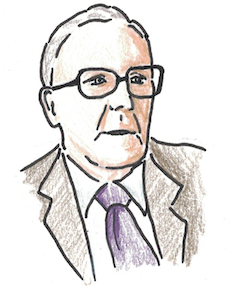
While mechanistic and cognitive theories continued to be popular well into the 1960s, critiques were mounting. Donald Hebb noted that existing theories were too focused on reacting to the immediate environment. Internal stimulation (thoughts, ideas, goals) could be just as powerful for triggering action as the sights and sounds around us:
“[T]he conclusion becomes inevitable that the nonsensory factor in cerebral action must be more consistently present and of more dominating importance than reluctant psychological theory had ever recognized. …
“Electrophysiology of the central nervous system indicates in brief that the brain is continuously active, in all its parts, and an afferent excitation must be superimposed on an already existent excitation.”16
John Atkinson and David Birch went on to note a “paradigm shift” in the study of motivation. 17 Early theories had defined motivation as, “how behavior gets started, is energized, is sustained,”18 but this ignored the fact that behavior never ceased. Motivation, then, couldn’t be seen as how actions get started, but how the organism decides to change its behavior from one thing to another.

Summary
Motivation has gone through different waves of research and theorizing:
-
- William James saw behavior as a cascade of habits. Voluntary acts occurred spontaneously, but we struggle with motivation when one idea robs another of its impulsive force.
-
- Sigmund Freud’s lasting impression was the importance of the unconscious mind.
-
- Clark Hull formulated motivation in terms of drives. A seductive theory, but one that has largely not held up to further scrutiny.
-
- Kurt Lewin and Edward Tolman contributed to the theory of motivation based on expectations.
-
- Various researchers from Donald Hebb to John Atkinson challenged the fundamental premise of motivation–that it was about initiating action. Instead, behavior is continuous–the question is why we change what we’re doing.
Theories of motivation have elaborated and expanded in the years following the cognitive revolution. Neuroscience has dug into the mechanisms that underpin motivation. Social psychologists have probed into the nuances that determine what shapes our interests. Before we dig into these topics, however, let’s take a closer look at the behaviorist research that started it all.
Reinforcement Learning: Motivation is What Gets Rewarded
Behaviorism was the dominant philosophy of American experimental psychology in the first half of 20th century.19 The basic motivation was to push away from armchair introspection and ground all experiments in what could actually be observed: behavior.
The cognitive revolution of the second half of the 20th century repealed many behaviorist dogmas.20 Explaining behavior without recourse to the externally invisible qualities of attention, memory, emotion or consciousness was doomed to failure.
Behaviorism today has largely been marginalized. But the empirical evidence gathered when it held sway have remained powerful in understanding motivation. The ideas behind classical and operant conditioning are still widely accepted today.
The Basics: Reinforcement, Punishment and Extinction

As mentioned in the History of Motivation, Thorndike’s Law of Effect stated that rewarded behaviors tended to increase. This led B.F. Skinner to the study of instrumental conditioning.21 Through varying rewards and punishments, Skinner could see how the behavior of rats and pigeons in his “Skinner box” could be manipulated by applying rewards and punishments.
In describing this paradigm, some terminology is helpful:
-
- Positive reinforcement. When the addition of something good increases the behavior. (AKA rewards)
-
- Positive punishment. When the addition of something bad decreases a behavior. (e.g. shocking an animal that produces an incorrect response.)
-
- Negative reinforcement. The removal of something bad to increase behavior. (e.g. removing a loud and annoying sound when a button is pressed.)
-
- Negative punishment. The removal of something good to decrease behavior. (e.g. removing access to a food source.)

These terms are often confused in popular discussions. Negative reinforcement, for instance, is often falsely equated to positive punishment. The terms negative and positive, however, are not synonyms for punishment and reward. Rather, negative refers to something being taken away and positive refers to something being added. Reinforcement means the behavior increases as a result. Punishment means it decreases.
Extinction is the tendency for a behavior to return to a baseline level once it is no longer subject to reward contingencies. Many experiments investigate the persistence of behavior outside of the conditioning phase.
Gambling and Games: The Power of Variable-Ratio Reinforcement
One surprising observation of experiments has been that when a behavior is rewarded only some of the time, it tends to be stronger and more persistent than when it is rewarded continuously.22
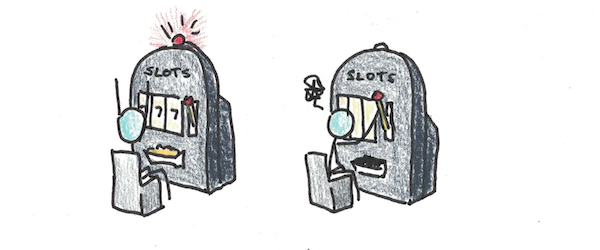
Gambling involves a variable-ratio reinforcement schedule, where not all pulls of the slot machine result in a win. This can make gambling behavior harder to quit.23 Video games and other services may also make use of a variable-ratio reinforcement schedule to make behavior more persistent.24
The idea that a behavior partly rewarded would lead to a stronger reinforcement than one which is always rewarded was puzzling to many early behaviorists.25 However, it can make sense if we view the organism as having a representation of the causal structure of the reinforcement mechanism. A predictable reward that stops might be a resource that has run out. An unpredictable reward that stops might simply be experiencing a random cessation between rewards. Thus persisting longer makes sense, even if the rewards have stopped.
The Neuroscience of Motivation
Neuroscientific research is exciting. It spans the frontier between mind and matter, allowing us to peer into how blob of tissue sitting in our skulls creates all the experiences of our lives.
But neuroscience can often be frighteningly complicated. To make matters easier, I’m going to try to give a simplified picture of what we know about motivation in the brain.
A Quick, Simplified Primer to Neuroscience
The basics of neuroscience don’t require a PhD to understand.
Our brains are made up of neurons. Neurons connect to each other with spindly axons and dendrites, like wires in a circuit. They signal via action potentials, little pulses of electricity. The pulses are either all on or off, like 1s and 0s in a computer, but the frequency of pulses can be sped up or slowed down depending on the strength of response.

Neurons communicate over synapses. These are microscopic gaps where the neurons almost touch. From there, neurotransmitters, tiny chemicals, get dumped into the gap, allowing a message to be sent from one neuron to another. Like a lock fitting into a key, these bind to receptors, which makes the neuron slightly more or less likely to fire.

Different networks in the brain use different neurotransmitters. An important one for this discussion of motivation is dopamine, as the neurons that communicate with this transmitter are involved in predicting rewards.
Taking Action: The Motor Loop
One challenge of having a brain with tons of independent neurons is that sometimes you need one and only one response. If you simultaneously tried to sit down and stand up to grab a glass of water, you’d probably fall down.
One way the brain overcomes this is through a pattern called the motor loop.26 This is a series of connections, starting with the cortex, going through the basal ganglia, thalamus and finally back up to the cortex that allows for this one-action-at-a-time control. Like an intricate locking mechanism, these not only make sure we don’t stumble, but are also involved in gating our thoughts and emotions as well.

To understand how this loop works, we need to look at three different brain areas: the cerebral cortex, the basal ganglia and the substantia nigra.
The cerebral cortex is the wrinkly outer part of the brain. This is mostly what you see when you look at pictures of the brain. It’s organized as a surface, into six distinct layers.27 It looks crumpled up for a reason—if you were to spread it out, it would take up almost two and a half square feet in size.28 Like a sheet of paper fitting into a ball, it needs to crumple to fit inside our skulls.

The basal ganglia sits beneath the cortex, so it’s only visible from cross sections or illustrations. It has many parts, but for the purpose of this simplified explanation, we can think of it as the place where the locking mechanisms exist.
The substantia nigra or “black matter” is so called because it contains many dopamine rich neurons and neuromelanin which make it appear dark.29 From its place in the midbrain, it has connections to the basal ganglia. It’s important for telling the basal ganglia which signals to lock and which to unlock.
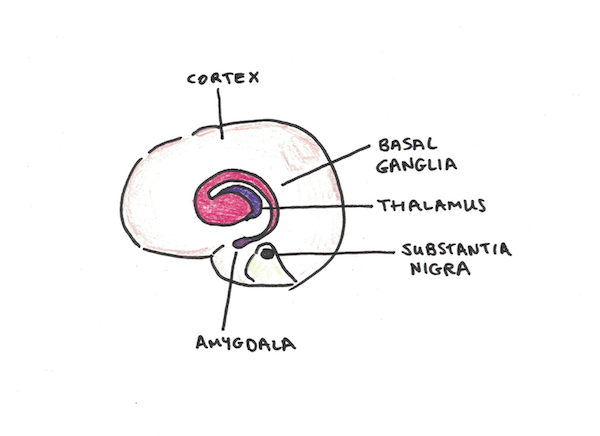
Putting these three together, and we have a loop:
-
- The first neuron starts in the cerebral cortex. It encodes the “idea” for the action. Actual muscle movements are coordinated by the brain stem, so the representation is at least somewhat abstract.
-
- This connects with the basal ganglia. By default this clamps down on output. But, it also receives input from the dopaminergic neurons of the substantia nigra. These can “unclamp” the lock.
-
- With the lock unclamped, and by way of the thalamus as a relay center, the signal returns to the cerebral cortex. This then sends the signal down to lower motor neurons which actually control the details of the movement in the body.

The unclamping mechanism in the second step is performed by parallel indirect and direct pathways, which both result in increasing activation. This forms a center-surround pattern where a focal pattern is enhanced and nearby patterns are suppressed.30 In this case, it allows a single action to be performed, preventing other actions from being performed at the same time.

This motor loop, as described, applies to movements of your body. But the same pattern extends, in slightly different parts of the basal ganglia, to signals from different parts of the cortex. This includes frontal lobe areas which are argued to play a role in working memory as well as insular cortical areas thought to play a role in emotions.3132
Parkinsons’ disease, which is characterized by a major loss of dopamenergic neurons in the substantia nigra, often results in difficulty initiating and controlling action.33 It’s as if the key has gotten rusty, so it no longer reliably releases the lock.
How Do We Decide Which Action to Take?
If the motor loop explains how we choose, what’s the mechanism for explaining which actions we pick. Why do we take one action and not another?
For that, we can focus in on the dopamine network.
The dopamine network plays a central role in motivation. In popular consciousness, dopamine is often equated with pleasure. Describing the “dopamine rush” of drugs, gambling or addictive internet behavior makes it appear as if dopamine is the chemical that makes you feel good.
The truth is a little more complicated.34 For starters, while dopamine networks do seem to be involved in drives or the experience of wanting, the nucleus accumbens and opiod networks are probably more closely linked to pleasure and the experience of liking. To grossly simplify, dopamine circuits are what make you desire chocolate, not necessarily what allow you to enjoy tasting it.

Second, the role of the dopamine network isn’t just to notice rewards, but to predict them. Primate studies show that the surge in activation doesn’t occur when you experience the reward, but when you anticipate it.35 The reward itself, coming later, doesn’t cause the same activation.
A better analogy for the role of dopamine is incentive salience. It’s a signal to your brain saying, basically, “Something unexpectedly good is going to happen—pay attention.”

Our brains are constantly anticipating rewards, and using that anticipation to guide our thoughts and behavior. This is normally good, as it drives us to do the things that will let us survive and thrive. However, the algorithm may backfire in cases of addiction, where we’re driven to do things that are actually harmful for us.
Is There One Type of Reward or Many?
A current area of debate between neuroscientific and psychological descriptions of motivation, is whether rewards are all the same, or whether different rewards motivate us differently. Neuroscience has tended to favor the “common currency” view, that all rewards get translated into some generic value.36 Psychologists, on the other hand, have observed that different motivations can compete (see: Intrinsic and Extrinsic Motivation).

A common currency of reward may be necessary at some stage of processing, as we’re constantly choosing between incompatible rewards (e.g. “Should I take a nap or eat a snack?”). How rewards get integrated, including how they potentially conflict, is an open area of research.
Addiction: What Happens When Motivation Malfunctions?
Our motivational hardwiring may be sophisticated, but it’s not perfect. Addiction can be seen as a motivational malfunction: the drive to do something far exceeds its value, which may even be negative.
Some drugs act directly upon the motivational circuitry of our brain, which explains their highly addictive potential. Cocaine prevents the reuptake of dopamine, chemically inducing the “something unexpectedly good happened” signal.37 The opiod network often corresponds to the experience of pleasure and suppression of pain, so it’s no wonder drugs which artificially activate it are addictive.
Many systems in biology are designed to return to a neutral level after a disruption. Not only does this make our design robust to random changes in the environment, it acts as a safeguard in case our own bodies malfunction. This results in an opposing process, whereby artificially increased activation can result in reduced natural activation later.
Solomon and Corbit proposed this opponent-process theory of motivation, which argues that for every stimulus that adjusts a set point in the brain, there is a later, counter-process which inactivates the first.38
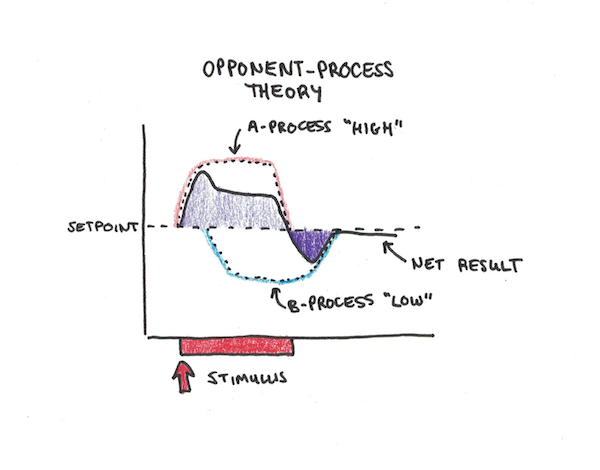
Neuroscientist and addiction research Judith Grisel explains:
[Opponent-process theory] explains why the states of withdrawal and craving from any drug are always exactly opposite to the drug’s effects. If a drug makes you feel relaxed, withdrawal and craving are experienced as anxiety and tension. If a drug helps you wake up, adaptation includes lethargy; if it reduces pain sensations, suffering will be your lot.39
While gambling, sex or other vices don’t directly introduce new chemicals into our brain, they too can cause our motivation to malfunction. As mentioned previously, the variable-ratio rewards used in casinos and some video games can lead to powerful reinforcement.
Anxiety and Avoidance: The Flipside of Drive
Fear and anxiety are the opposite side of the motivational coin. While drives compel us to act, fears compel us to avoid.
The amygdala plays a central role in our detection of threats. It has often been popularized as the brain’s “fear center.” Neuroscientist and anxiety researcher, Joseph LeDoux argues against this overinterpretation, however.40 He argues that the processing in the amygdala is probably outside of our awareness. Fear and anxiety as a conscious experience likely requires cortical activity, for which input from the amygdala is just one source. Instead, a better view of the amygdala is as an unconscious “threat detection center.”
Requiring multiple dangerous encounters to learn about a threat is often deadly. As a result, learning here is often quick and more general than it is for other areas. The amygdala even receives sensory inputs before they are fully processed by the cortex—allowing a quick reaction time, even before you consciously perceive what you’re reacting to.41
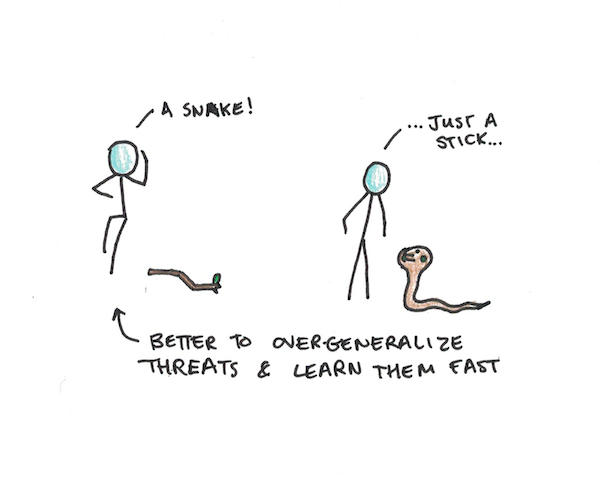
Fears can be suppressed through learning safety. However, it appears that the circuitry for suppression is separate from the circuitry for threat detection itself. Learning safety, in contrast to learning threat, appears to be slower and more context-specific than the fear itself.42
This can be a challenge to therapists who want to treat clients with anxieties or phobias—they may quell the phobia in one area, but not others. Someone who has social anxiety may start to feel better in the company of a friend, but once the friend goes the anxiety returns. The anxiety was learned somewhat generally, but the learned suppression of the anxiety may be more specific.
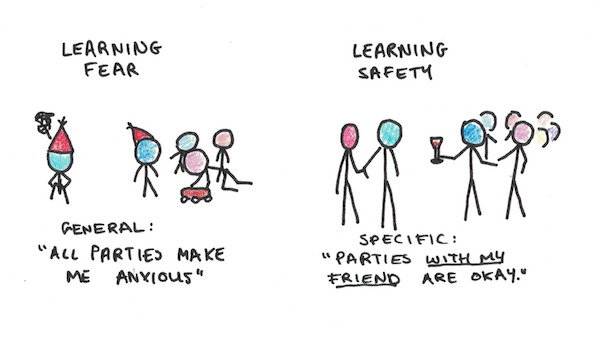
Avoidance is a common response to anxiety. You avoid situations your amygdala has learned are potentially threatening. Faced with genuine danger, this is an adaptive response.
When avoidance malfunctions, however, this response can become a self-supporting cycle.43 You feel anxiety and avoid situations that might trigger those negative feelings. But in avoiding those triggers, you never experience the situation without danger. Just as addiction can result in the compulsive action, beyond what is useful, anxiety can result in compulsive avoidance, beyond what actual helps reduce threats.
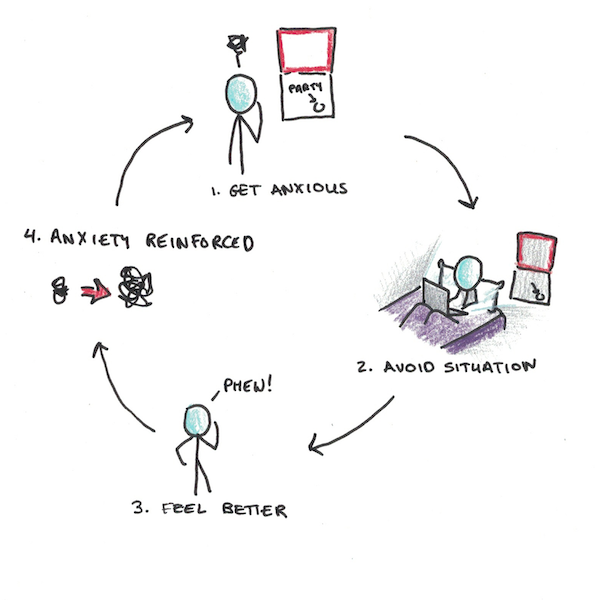
Summary
Neuroscience offers us tantalizing clues to how motivation operates within the brain:
-
- The motor loop functions to allow us to take only one action at a time. It does this through a series of connections going through the cortex, basal ganglia, thalamus and finally back up to the cortex.
-
- The action that goes through this locking mechanism depends heavily on dopaminergic neurons. These neurons learn to predict rewards, suggesting they may be the site for where reinforcement learning takes place.
-
- The brain regions responsible for wanting and liking are different. While these are normally related, it’s possible to want something without liking it, or enjoy something without craving.
-
- Addiction is a motivational disorder that occurs when the drive to do something greatly exceeds its value (which can become negative).
-
- Opponent processing theory suggests that when we experience a high, our brain restores equilibrium by creating an opposite “low” feeling.
-
- Fear and anxiety impact motivation through avoidance. While our amygdala learns to spot threats generally, it is more specific when learning safety.
-
- We can get stuck in an avoidance loop, where our anxiety keeps us from exposing ourselves to the evidence that our fears are baseless.
Neuroscience offers an intriguing account of some of the basic principles of motivation. However, often the real motivational drivers of our actions are much more abstract and complicated than a rat in an experiment. Thus, to better understand what motivates us, I want to shift from neuroscience to social psychology, describing one of the more prominent theories of human motivation: self-determination theory.
Self-Determination Theory: Motivation Beyond Manipulation?
Early research on motivation often took a simplistic view of human nature. Behaviorists posited that the actions people took were simply responses to previously reinforced stimuli. Consciousness, thinking and choice were banished from the psychological vocabulary as being unobservable, and thus, unscientific.
Later cognitive theorists improved matters, invoking ideas of expectations rather than mere conditioning. However, the models of motivation remained fairly simple: expect rewards and behavior increases.
Psychologists, Edward Ryan and Richard Deci, argued that this view of human motivation was misguided:
“The dominant approaches to these topics focused … on how they could be controlled to behave or change using external contingencies and cognitive manipulations. To us, this was a science pointing in the wrong direction. Our interest was not in how motivation can be controlled from without, but instead in how human motivation is functionally designed and experienced from within”44
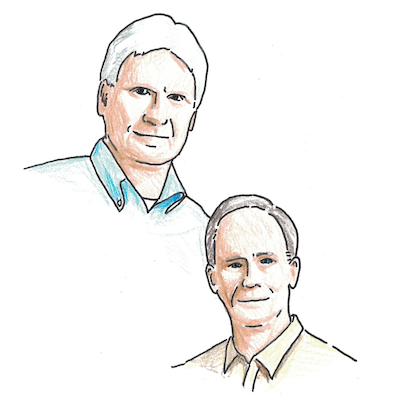
Self-Determination Theory took this observation and made empirical predictions: people have an innate tendency to pursue basic psychological needs of autonomy, competence and relatedness. Deprive someone of autonomy (by manipulating their choices), and their intrinsic motivation may go down. In this sense, it’s not simply the reward contingencies that matter—how we interpret the rewards around us matters too.
Intrinsic vs Extrinsic Motivation: Does Expecting Pay Make Work Less Fun?
If you got paid to do an activity, would you find it less fun afterwards?
It was this question that Deci asked in his now-famous experiment on the interaction between intrinsic and extrinsic motivation.45
Early behaviorists would have argued that motivations are strictly additive. A fun activity that is also rewarded would increase the behavior, not decrease it. In fact, many behaviorists suggested exactly this strategy: parents, managers and teachers ought to give rewards so as to increase the desired behavior.
Using an experiment known as the free-choice paradigm, Deci tested this by asking two groups of volunteers to complete puzzles. One group was told they would be paid one dollar for each puzzle solved, while another group was just asked to work on them without any expectation of reward.
After this part was finished, and subjects thought the experiment was over, the real test began. Would subjects who were rewarded persist in playing with the puzzles for more or less time than the unrewarded subject?

Contrary to behaviorist predictions, being rewarded resulted in less time spent on the puzzles after, when subjects no longer expected the rewards to continue. Deci interpreted this finding to be that, in incentivizing people to complete the puzzles, their intrinsic interest in completing them was diminished.
Following up with many other studies, researchers found that the form of the reward mattered greatly. Positive feedback, because it is usually not expected and often has positive informational value related to competence (more on basic needs below), often increases intrinsic motivation.46 Similarly non-contingent rewards, which participants didn’t expect or weren’t related to completion of the activity did not have such a negative effect.47 Presumably this is because subjects don’t interpret their behavior as having been controlled by the external contingencies.
A common misunderstanding of this research is that it suggests all external incentives are harmful or useless. As Ryan and Deci themselves argue, this isn’t the case:
“External regulators can, in fact, be powerfully motivating in an immediate sense—they can compel or seduce people into action, and they offer quick tools to mobilize behavior. The issue we shall raise about them is not their potential short-term potency but, rather, the fact that they have not been internalized and that, therefore, the external regulation is often associated with poor maintenance and transfer.”48
Control undermines intrinsic motivation because you feel you are doing things to get the reward, rather than as a self-chosen activity. But this raises a deeper question: what does it mean for an action to be self-chosen?
What is the Self? A Modern Take on an Ancient Problem
Central to Self-Determination Theory is the idea that we are more motivated to pursue actions that emanate from the self. When we feel our behavior is being controlled or guided by a non-self source, our motivation diminishes.
But what is the self? In their work, Ryan and Deci define the self as being the “center of volition and organizer of experience.”49 In other words, the self is something you experience. Self-chosen actions are those you enthusiastically endorse.
This definition separates from other possible definitions of the self. For the purposes of this theory, the self shouldn’t be conflated with:
-
- Identity or Self-Concept. In Ryan and Deci’s view, the self isn’t a picture you hold of yourself. It’s not an object in your mind that’s only present some of the time (when you’re self-aware). Their view of the self is closer to volition or willingness.
-
- Consciousness or Deliberateness. While automatic or delegated actions are often less volitional, this isn’t always the case. I can fully endorse my doctor’s recommendations for my medication. Thus when I take my medicine, I feel like “I” am doing it, not merely being coerced. Similarly, I can also continue a habit of brushing my teeth without realizing it, but upon reflection realize it is what I would have wanted to do anyways.
-
- Free Will. While voluntary actions always have antecedent causes that are outside of oneself, one doesn’t need to be metaphysically separate from the rest of the universe to have a self. The self is defined phenomenologically, not metaphysically.
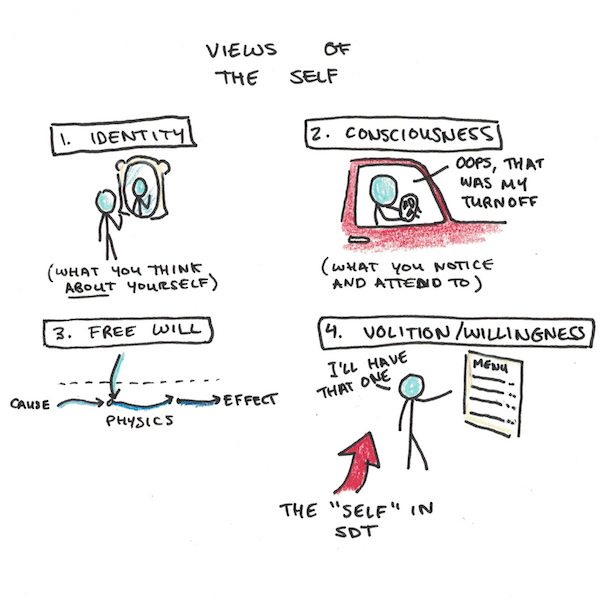
What makes a motivation originate with the self is based on your experience of it. Does the motivation feel like its yours? Is it a controlling influence by others? The source of a motivation can end up making a big difference in how earnestly and eagerly we pursue it, as we shall see.
Integration and the Self: Why We Struggle to Motivate Ourselves to Do the Things We Should
The experience of autonomy, of one’s actions originating from oneself, is a matter of degree. Some actions feel completely controlled. Others feel completely spontaneous and self-endorsed. But most are somewhere in-between.
Ryan and Deci argue there are six different levels of motivation, spread over three types.50 Those levels are:
-
- Amotivation – An utter lack of motivation to act. This could be because you feel like you lack the ability to do anything about the situation (helplessness) or because you don’t attach any value you to it.
-
- External regulation – When you’re motivated to act, based on external contingencies. A child who only follows rules when not being watched is under external regulation. Remove rewards and punishments and the controlled behavior ceases.
-
- Introjection – When your motives to act come primarily in the form of guilt/shame. In this case, you don’t identify with the behavior (it is self-alien) but you may perform it even when contingencies are removed. For instance, the student who goes to medical school to fulfill his parent’s wishes for him to become a doctor, but doesn’t really want to do so himself.
-
- Identification – When you agree to the behavior and identify personally with the reasons. However, the identification may be partial or limited in context. You agree you ought to exercise to be in shape, but you don’t always follow through, perhaps because it conflicts with your views that you need time to relax.
-
- Integration – When the identification becomes a part of your identity. You not only agree you ought to exercise, but the decision to exercise feels fully and centrally part of yourself.
-
- Intrinsic Motivation – When you spontaneously engage in the activity for its inherent value. You exercise because it’s fun.
These are sorted into three types: amotivation, external and intrinsic. Ryan and Deci note that integration may be more useful than intrinsic motivation for activities that are not automatically fun. In one study, for instance, integrated reasons for political involvement better predicted actual voting behavior than merely intrinsic interest in politics.51

Introjected reasons also help to explain why we struggle to motivate ourselves to perform many actions. Since the actions stem from a perceived pressure or control outside the self, there tends to be lowered intrinsic interest in pursuing it.
Ryan and Deci argue that the process of socialization, where cultural and familial rules and norms get internalized, works by a process of integrating external regulations into oneself. This process proceeds best when the environment is needs-supportive.52 Controlling and manipulating environments make it less likely that one will integrate the behaviors.
Integration does not proceed in only one direction, nor is it a universal developmental stage.53 Thus for all adults there will be a mixture of regulating, introjecting, identified and integrated external motivators. These will vary depending on the context and situation. They may also become more integrated (brought closer to the self) or rejected (pushed away from the self).
Basic Psychological Needs: Autonomy, Competence and Relatedness
Why are self-authored actions more robustly motivating, when external constraints are removed? Why do people who have more integrated motivations experience less conflict and greater well-being in school, work and in relationships?
Ryan and Deci argue that, in addition to our physiological needs of food, water and shelter, we also have psychological needs.54 Deprived of these needs causes ill-being in the same way that depriving someone of water causes ill health. What is more, these needs don’t satiate—so providing even more of them is better, without limit.
These basic psychological needs are:
-
- Autonomy. As discussed, the experience that one’s behavior originates with the self—that is it is enthusiastically endorsed and free from manipulation or coercion.
-
- Competence. The belief that one can effectively control or achieve the outcomes desired in a situation.
-
- Relatedness. The need to feel close to others, to be respected and treated as a person, not an object.
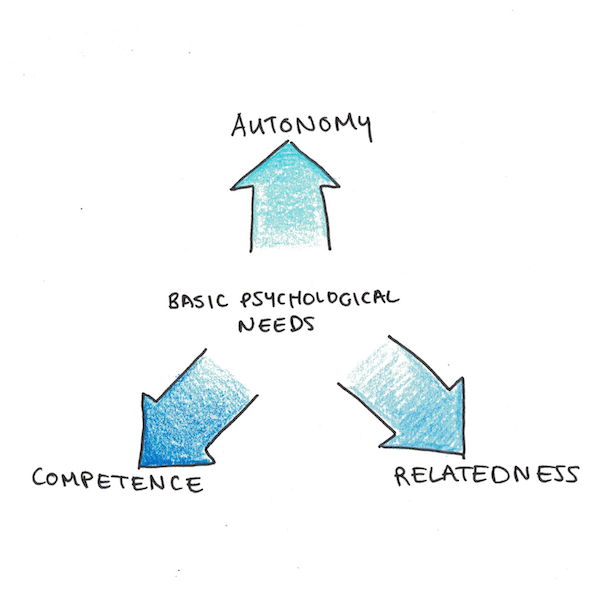
Viewed from the lens of basic needs, we can see why introjected motivations—ones in which the person feels compelled to do things out of guilt or obligation—are often less conducive to well-being than integrated ones. In introjected motivations, there is a conflict between one’s autonomy and relatedness. The need to make one’s own decision feels compromised by the need to maintain relationships.
Goal Contents Theory: Why Trying to Be Rich Might Make You Miserable
Applying the idea of basic needs we can now turn to another prediction of Self-Determination Theory: not all goals will equally lead to satisfaction and well-being.
Recall earlier expectancy-value theorists argued that what mattered for motivation was primarily how much a person valued something and how likely they thought they could achieve it. The contents of the goal didn’t matter, merely how much you valued it. Whether it was world peace or world domination, as long as you valued it highly and expected to achieve it, you would be motivated and satisfied upon reaching it.
Goal Contents Theory, in contrast, argues that our fundamental drives are to satisfy basic psychological needs, independent of our personal or cultural values. Thus the contents of some goals are mistaken, if achieving them does not result in increased levels of autonomy, competence or relatedness.
To demonstrate this, researchers studied people in both the United States and Russia. External goals, such as wealth, fame or image, were found to be negatively related to well-being and vitality. In contrast, internal goals, such as personal growth or community service, were related to positive well-being.55
In other words, reality and human nature are not value neutral. If your goal is to become really rich, this may be masking a desire for relatedness (wanting to be loved/respected). Yet if this goal doesn’t help you to achieve your needs, you may be worse off reaching it than not.

While the study authors tended to focus on materialistic goals as imputing extrinsic motivations, there is some nuance to this. Wanting to pursue these goals in ways that satisfy basic needs, such as saving for retirement so one can enjoy more freedom or to provide a more comfortable life for one’s family, were positively associated with well-being.56 Thus, this research suggests that while goal contents matter, the underlying reasons may matter more.
Self-Determination Theory in Summary
Self-Determination Theory argues that it is a tendency of all life to self-organize. In humans, this means cultivating an autonomous self, whose actions are fully endorsed and performed willingly. This innate drive for growth and exploration is central to our motivational make-up.
Rewards and extrinsic incentives have the potential to decrease intrinsic motivation. Important is the interpretation of the incentives, not merely their form. Positive feedback or rewards that were not made contingent on performance, often don’t share this motivational crowding out as participants do no construe their earlier behavior as being performed in order to get the rewards.
Socialization is the process by which cultural norms and external regulation gets internalized. It proceeds from regulation (where concrete rewards/punishments provide the motivation), to introjection (where one experiences an inner feeling of coercion, even absent regulation), and finally to identification and integration.
Human beings have three basic psychological needs: autonomy, competence and relatedness. Our internal motivations often depend on how these needs are satisfied (or thwarted) by our surroundings. Goals that satisfy these needs tend to be more motivating and promote well-being, while goals which do not may end up causing more harm than good.
Modeling Motivation: Rationality, Signaling and Bias
So far, this guide has focused mostly on psychological and neuroscientific understandings of motivation. But other fields have also, somewhat independently, come to their own ideas about what causes human beings to act. In particular, economics and game theory have a lot of interesting insights into behavior, despite having different perspectives on the question.
Rational Choice Theory: Does Rational Motivation Explain Large-Scale Behavior?
A common framework in economics is Rational Choice Theory.57 This theory suggests that aggregate human behavior can be explained by individuals making rational choices. If you want to understand how a market, or a global economy, will function, you first have to understand the motivations of each individual.

More specifically, Rational Choice Theory models human beings as utility-maximizers, according to their set of preferences. Given a set of actions to choose from, people will do whatever improves their utility the most.
Such a theory may sound oversimplified, but it should sound familiar. Lewis and Tolman’s cognitive theory of motivation, was similar—with human beings maximizing their value combined by the expectation of success for each action. A common currency of reward being optimized for also features strongly in many neuroscientific theories of motivation we just discussed.
There are two advantages to the assumption of rationality that economists’ theories often make:
-
- It allows you to predict large-scale behavior. The practice of using a simple model for components to understand a more complicated system made up of it is common throughout science. Electrical engineers use a simplified model of a transistor when anticipating the computational properties of a circuit. Human rationality may be imperfect, but it often works surprisingly well.
-
- It forces you to dig deeper into the potential unseen motivations. Assuming rationality with unseen preferences and utilities often recasts a question such as, “Why would that person be so stupid?” as, “What could be that person’s incentives and expectations?”
Signaling: Do Hidden Motivations Drive Much of Life?
That a seemingly irrational decision may involve a hidden logic is clearest with signaling.
Signaling is the idea of taking an action, not because of its intrinsic utility, but because of what it functions to communicate about you. Signaling theories are common in evolutionary biology, where they are used to explain many diverse phenomena such as the peacock’s unwieldly and beautiful tail or the habit of antelope to leap straight up into the air when they spot a predator.5859
At first glance, the peacock’s tail doesn’t make much sense. It’s huge and makes it much harder to fly. This, however, is precisely why it works. The tail is costly. Thus, to be able to survive and sport a fancy tail requires healthy genes. Thus for the peahen, a beautiful tail is strong evidence of evolutionary fitness.

According to economist Robin Hanson, much of human motivations depend on signaling.60 Except, being more sophisticated than peacocks, we use signals for a variety of purposes. Among the institutions he believes are best explained by hidden motivations, he includes:
-
- Education. We care about credentials more than learning. Schools serve to demonstrate smarts, conformity and work-ethic, not mainly to teach useful things.
The signaling explanation, to the extent it is true, would also explain why many of our motivations feel so irrational: they work best as signals when other people believe we hold them sincerely. This suggests we might consciously cover over our deeper motivations because to express them aloud would undermine our goals.
Prospect Theory: Rationality Under Strain
While the assumption of rationality remains prevalent and popular in economics, the theory has endured some attacks. Notably, the psychologists Daniel Kahneman and Amos Tversky popularized an alternative, known as Prospect Theory, that argues we are reliably irrational in our decision-making.61
Loss aversion argues that we’ll work harder (and take on bigger risks) to avoid losses than to get equivalent gains. This has often been argued as a violation of human rationality, as it’s possible to construct identical scenarios, but framed in terms of gains or losses, that will result in people making different decisions.
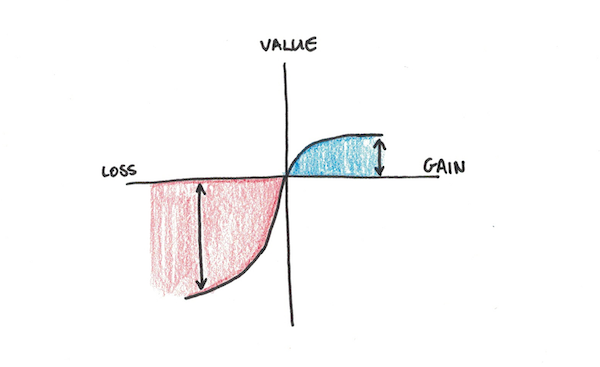
Side note: Not everyone accepts that loss aversion implies irrationality. See here a technical argument showing that since the expected payoff for bets is non-ergodic, the typical participant won’t realize the expected value in the long-run.
Loss aversion is just one possible bias of many being considered into a newer formulation of behavioral economics. Some biases are argued to result from quick, heuristic thinking, as opposed to slow, deliberate thinking.62 Making snap judgements, we may unwittingly rely on lousy approximations when making our choices.
Other biases may be due to fundamental limitations in cognition itself. Bounded rationality, which assumes we have limited space in exploring all possibilities, represents a major limitation in our ability to make the right choice.63 Some problems, such as navigating explore-and-exploit trade-offs may be inherently impossible to solve completely, thus heuristic solutions are necessary.64

If human beings are predictably irrational, as some researchers have claimed, contra standard economic thinking, then perhaps human motivations ought to be “nudged” to better promote human welfare.65
Summary
Economics offers interesting perspectives on human motivation:
-
- Rational Choice Theory makes predictions about large-scale behavior, by assuming human beings are motivated to maximize their utility.
-
- Bounded rationality argues that we can’t consider all options, even if we didn’t make mistakes.
-
- Signaling theories suggest that we are motivated to do things, in part, to send signals to other people about what sorts of people we are, our loyalties and preferences. These motivations may be hidden from our conscious minds.
-
- Prospect theory argues we treat losses differently than corresponding gains. In addition, we have numerous other psychological biases that cause us to predictably deviate from the predictions of rational models of motivation.
Now let’s shift from discussing motivation in general to what compels us to learn.
Curiosity and Boredom: What Motivates Learning?
Curiosity is one of our most celebrated motivations. But it has also been one of our most mysterious.

Early research on curiosity was often formulated in terms of drives.66 These theories tended to assume that curiosity itself was aversive, and that it motivated us to reduce the unpleasant state of ignorance by exploring. However, as noted before with other drives, these theories often made it hard to explain why someone would want to increase their curiosity, say by reading a murder mystery novel.
Later research tried to distinguish trait curiosity, which refers to how curious a person is in general, and state curiosity, which would be the curiosity exhibited for specific items. Unfortunately, research into trait curiosity has often been difficult, with some researchers speculating that it may not even exist.67
Information-Gap Theory: How Much Info Are You Missing?
Loewenstein developed the information-gap theory of curiosity.68 This theory argues that the intensity of curiosity you experience is controlled by the gap between what you know and what you’d like to know.
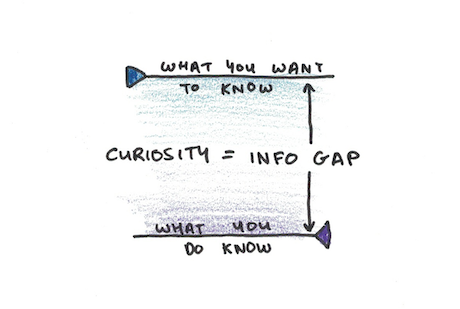
Central to the information-gap theory perspective is that:
-
- The intensity of curiosity should be related to your ability to close the gap.
-
- The more you know about something, the more curious you are about it. As your knowledge grows, the gaps between what you know and what you don’t become more salient. (e.g. Compare knowing only 3 of the 50 states, to knowing 47 out of 50.)
-
- Curiosity is susceptible to framing effects. Since how much knowledge is desired is subjective, it may change as the reference set is changed. Someone learning a new language may initially begin being highly curious to learn basic phrases, but as they learn these and realize how vast the unlearned knowledge is, curiosity may actually decline.
Insight-based problems, where a single piece of information has the potential to create a breakthrough, ought to provoke more curiosity than problems which proceed step-by-step.
Friston and Free Energy: Curiosity as a Key to All of Neuroscience?
Most research on curiosity has relegated it to a subordinate position in the pantheon of human motivations. Some have placed it as a derivative drive, explainable in terms of more basic urges for food or sex. Others have made it a basic drive on its own, but otherwise unremarkable.
Karl Friston’s free energy theory of human neuroscience, then, is peculiar because it places the search for information as the central organizing principle of the entire brain. Curiosity not being just a side-character but the central protagonist.69

In a nutshell, the free-energy principle argues that we’re driven to reduce surprise. Exploration is seeking to reduce the difference between your mental model and the sensory world you actually experiences. Rewards get represented within this system as a limited set of a few innate, expected states—we then take action to reach these hardcoded states, in the process, reducing our uncertainty.
If true, this suggests that learning and exploratory behaviors are fundamental in neuroscience, and so our drive to remove uncertainty is the mechanism through which all other motivations are realized.
Learning Progress: An Algorithm for Curiosity?
What explains why we have a lot of interest to learn some things, while we find other subjects boring? Researchers Oudeyer, Kaplan and Hafner suggest a simple algorithm may be behind it.70
In trying to create a machine that explores the way children do, the researchers suggested that maximizing learning progress can account for a lot of the curiosity-driven behavior we observe.
In exploring, we find ourselves in one of three different situations:
-
- Predictable situations we’ve already understood and mastered.
-
- Unpredictable situations we have no hope of understanding. (Either because there isn’t a pattern to learn, or because it’s too difficult.)
-
- Learnable situations we haven’t yet grasped.
The first and second situations are bad places to keep exploring. We want to focus on the third situation, where learning progress can still be made and new opportunities unlocked. One way to do this to always move in the direction of greatest learning progress.

This model also explains two other features of our learning motivation:
-
- We may have difficulty motivating ourselves when new subjects have an initial barrier to learning progress.
-
- Learning may be a positive feedback loop. If learning unlocks more opportunities for progress, your interest may accelerate.
Boredom: More Interesting than it First Appears
Nobody likes to be bored. But sometimes we can’t choose a more interesting task. What can we do to make things more interesting?
Cognitive reappraisal often works as a strategy to alleviate boredom. In a study by Nett et al., students who reappraised situations (“How could I make this subject more interesting?”) experienced less boredom in class and had a better academic profile.71 Avoidance (“How can I daydream about something more interesting?”) was associated with both worse grades and more boredom. Faced with boredom you can’t escape, you’ll be better off reevaluating the situation.
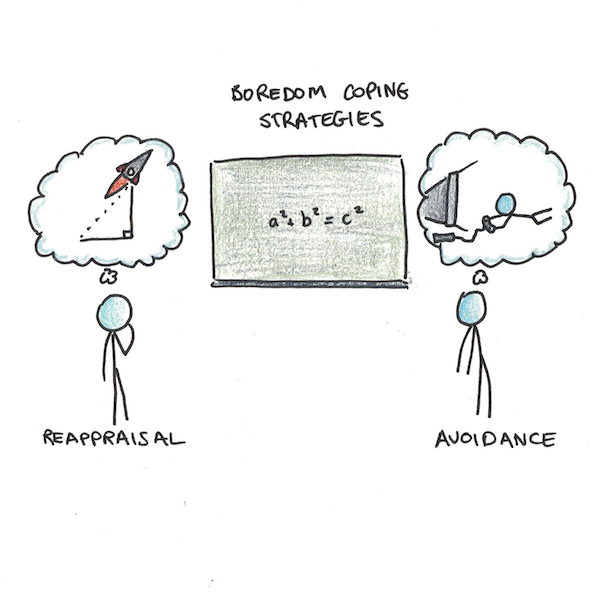
Boredom is usually negative, but some authors suggest it might still be useful. Mugon et al. proposed, “in-the-moment feelings of boredom can be an aid to learning.”72 How? Boredom acts as a signal to tell you that you’re not engaged with the material. While this can sometimes be a sign to give up, it can also be interpreted as a sign to change your approach. For instance:
-
- Can’t keep your mind from wandering while reading a dry text? What if you tried summarizing it instead.
-
- Eyes glazing over while reading an explanation? Maybe the problem is that you don’t really understand how it works. Try something active, like the Feynman Technique.
-
- Stuck on homework? Maybe the problems are too hard (and need to be broken up first) or too easy (and need an extra challenge) to make them more engaging?
Summary
Why are we motivated to learn? Some of the theories of curiosity and learning include:
-
- Information-gap theory. We feel curious when what we want to know is more than what we do know. Insight-based puzzles, where a single clue can provide the answer, ought to evoke more curiosity than accumulating facts. How a problem is framed may change our curiosity.
-
- Free-energy theory. An all-encompassing theory of the brain that makes reducing surprise the key principle of neuroscience. In this view, we explore in order to reduce ambiguities in our sensory experience.
-
- Learning progress. A simple model says that we are motivated to learn wherever progress is greatest. This allows us to avoid hopeless confusions and already-mastered material.
-
- Boredom. Reappraising works better than avoidance for boredom. Feeling bored itself may be a signal that you need to adjust your attention, rather than change tasks.
Procrastination: Why Do We Struggle to Start?
Procrastination is a major problem. As many as 95% of college students procrastinate, taking up over one third of their daily activities.7374 Procrastinating on taxes costs us hundreds of dollars per year.75 Procrastination on medical treatment can make you sick.

Across the board, procrastination results in worse grades, health and finances.76 Our happiness too, is impacted77 (although some procrastinators don’t seem bothered).78
Not all delay is procrastination, however. Indeed, since we can’t do everything all at once, some tasks must be delayed. To analyze procrastination, we first have to define it. Psychologist Piers Steel defines procrastination as:
Voluntarily delaying an intended course of action despite expecting to be worse off for the delay.79
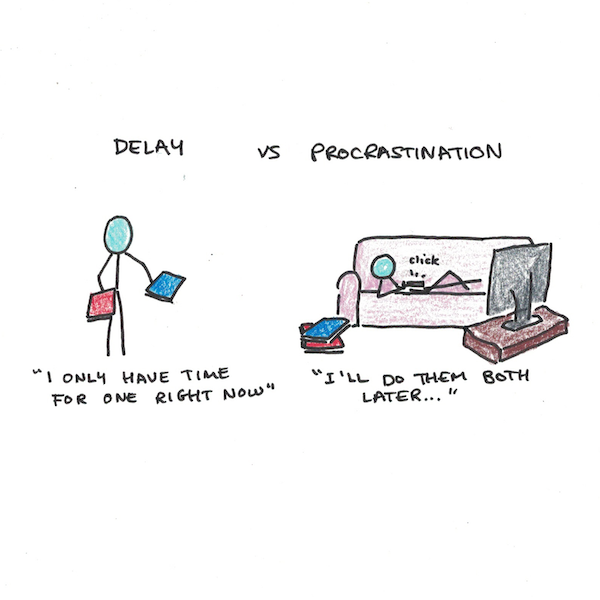
Procrastination is an ancient problem. The Greek poet Hesiod, around 800 BC said those who put off their work “till tomorrow and the day after” would always be “hand-grips with ruin.”80 But how has modern science considered this persistent problem?
Does Perfectionism Cause Procrastination?
Perfectionism is frequently blamed for procrastinating. So is anxiety. Unfortunately, research doesn’t put much support on either case.81
Theoretically, it’s unclear that perfectionism would lead to procrastination. After all, additional anxiety about your work might cause you to get to work right away. Being too optimistic can also lead to procrastination, as you delay work believing wrongly you’ll easily finish on time.
Empirically, perfectionism has only a weak relationship to procrastination. Within that, it’s mostly socially-prescribed perfectionism that has even a modest relationship.82
What Does Cause Procrastination?
If perfectionism, long-attacked as the source of procrastination, isn’t well-supported by research what is?
In a meta-analysis looking at many different studies of procrastination, Piers Steel found procrastination was associated with:83
-
- Task unpleasantness. Boring, frustrating and aversive tasks are more likely to cause procrastination.
-
- Self-efficacy. Your belief that you can perform the task strongly influences procrastination. This also relates to competence as a basic human need, broadly influencing motivation.
-
- Task delay. All else being equal, tasks where rewards and punishments are more distant are more likely to cause procrastination.
-
- Impulsiveness. Those who are distractable and have less impulse control are more likely to procrastinate.
-
- Organization. Being more organized was associated with less procrastination.
-
- Achievement motivation. Those who valued achievement higher tended to procrastinate less.
This assortment of effects (including the absence of an effect from perfectionism) is predicted by a simple theory of procrastination: temporal motivations theory.
Temporal Motivations Theory: The Formula for Procrastination
Temporal Motivations Theory is an elaboration of earlier expectancy-value theories of motivation, but with the addition of hyperbolic time discounting.84 Stated as a formula, it says:
Utility = (Expectation x Value) / (Time Delay * Delay Sensitivity)
Stated in English, this formula says that the utility you expect from a given action is the expectation multiplied by the value (as in prior cognitive theories of motivation), divided by the delay length combined with the sensitivity to delay.
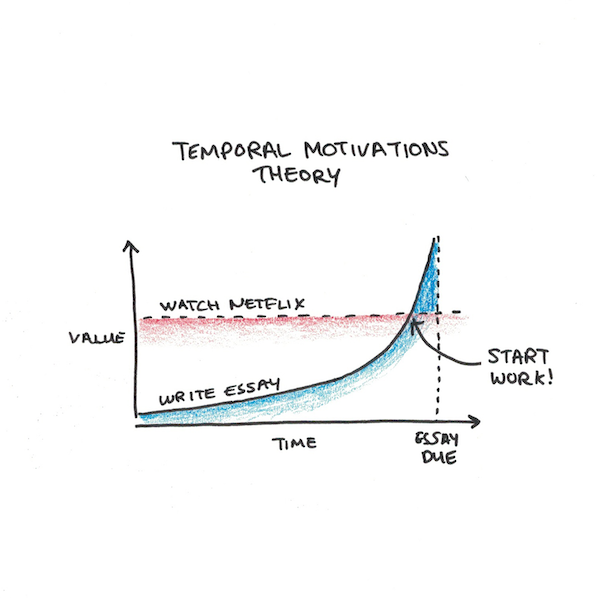
Procrastination will continue until the utility of work is greater than the utility of distraction. Steel illustrates with an example of a hypothetical student:
Tom has two choices over the course of his semester: studying or socializing. Tom likes to socialize, but he likes to get good grades even more. However, because the positive component of socializing is perpetually in the present, it maintains a uniformly high utility evaluation. The reward of writing is initially temporally distant, diminishing its utility. Only toward the deadline do the effects of discounting decrease, and writing becomes increasingly likely.85
This suggests that if you want to reduce procrastination, you ought to work on one of the fundamental variables in the equation: increase your expectancy of success, the value of the activity, reduce the perceived delay or your sensitivity to delay.
Strategies for Beating Procrastination
There are multiple strategies you can use to reduce procrastination. Since self-efficacy is related to procrastination, making the task easier (or just perceiving it to be easier) can help tip the balance.
Organization, in the form of setting goals that break down distant rewards into shorter time delays can also help.86 Since organizing a bigger task into subtasks can also make them easier to do, this can also assist with self-efficacy.87
Environmental change is also helpful since impulsiveness and distractability are associated with procrastination. Studies confirm that students who study in the same location procrastinated less.88
Overcoming procrastination is difficult. But what about being harder working, in general?
Learned Industriousness: Can Effort Become More Enjoyable?
Why do some people enjoy working hard while others are perpetually lazy? Personality and innate explanations are common, but it has long been observed that acquired attitudes can matter as well. Over a century ago, sociologist Max Weber argued that specific religious beliefs led to culturally differing levels of work ethic.89
One theory explaining how people might learn to be harder (or lazier) workers is Robert Eisenberg’s theory of learned industriousness.90
Learned industriousness claims that when you are rewarded for expending higher effort, the experience of effortful activity itself is reinforced. This leads to the experience of effort itself becoming less unpleasant, and thus changes your willingness to work harder for bigger payoffs.

Early theories of motivation long had noted that people tend to avoid expending effort when given a choice. Hull proposed the Law of Least Effort to accommodate this observation, noting that given two choices for obtaining a reward, animals will always choose the easier option.91
What Hull’s law couldn’t address, however, was the trade-off between a low-effort, small reward and a high-effort, big reward. What the theory of learned industriousness adds is that this trade-off point may not be fixed. As effort acquires secondary reinforcement, the high-effort, high-reward conditions tend to be more favored.
Experimental studies tend to support this view. In one study, college students were given anagram solving tasks.92 Some were given complex anagrams, others easy ones. Another group was given anagrams to specifically match the performance of the participants in the complex group. For each success in the complex group, they got an easy anagram. For each failure, they were given an impossible anagram.
This design essentially compared a group who was rewarded for high effort (the complex anagram group) with a group who was rewarded for low effort (the yoked, or matched, group). On later tests of persistence on difficult problems, the high-effort group did better than lower effort groups.

These effects are likely to be context specific, so if you experience rewards for high effort in athletics but not academics, you might train hard at the gym but procrastinate more in school. However, there is probably some transfer as well, so that those who generally experience rewards for high-effort find effort less costly to engage in.
Summary
What does research tell us about procrastination:
-
- It’s a serious problem, impacting most students. It causes financial, physical and emotional difficulties.
-
- Perfectionism and anxiety aren’t the main culprits. Instead, task aversiveness, self-efficacy, delay and organization matter more.
-
- Temporal motivations theory combines expectation-value theories with hyperbolic discounting to provide a mathematical description. To the extent this is true, it suggests the main ways to overcome procrastination are to increase the value of the task, your odds of success or to decrease the perceived delay or your sensitivity to delay.
-
- Getting more organized, changing your environment and setting shorter-term goals are all ways you can combat procrastinating.
-
- Learned industriousness suggests that as we get reinforced when putting in effort, exerting effort becomes less difficult. This can push you to do harder, more ambitious things with higher payoffs.
Goals: How Do Intentions Impact Results?
How do goals impact motivation? Edwin Locke began the modern study of goal-setting in the 1960s.93 Summarizing his and his colleagues work over three decades, Locke finds that the goals one sets can have a big impact on performance.94 They do so through four different mechanisms:
-
- Goals direct your attention. Rothkopf and Billington found that students paid more attention to passages of text that related to their learning goals than irrelevant passages.

Setting goals works, but what kind of goals should you set?
Harder Goals Lead to Better Performance
Experiments have found that harder goals resulted in better performance than easier goals. In particular, Locke’s research observed a linear relationship with goal difficulty and performance—harder goals result in harder work.95
This result was somewhat surprising. Earlier research by Atkinson on achievement motivation had hypothesized that moderate levels of difficulty resulted in the greatest motivation.96
The difference appears to be that harder goals work better, provided the goals are accepted by the participant. Harder goals may not be accepted by the participant, especially if they deem it unlikely they will achieve it. However, provided the goals are accepted, harder goals lead to better performance.

Specific Standards Beat “Doing Your Best”
Specific and clear standards, rather than telling people to “do their best” also improved performance. Quoting Locke, in his review of a meta-analysis supporting these effects, “In short, when people are asked to do their best, they do not do so.”97

A mitigating factor in this, however, is task-complexity. Research by Earley et al., noted that when a task is too complex, hard performance goals can sometimes prevent finding an effective strategy. In these particular cases, “doing your best” may be a better approach.98
Other research noted that harder goals led to worse performance with air traffic controllers.99 Although Locke and other goal theorists have argued that while performance goals, when set too high, can interfere with learning, a learning goal ought to do better.100 Research on mindsets also supports the distinction between learning and performance goals, finding the latter often results in worse academic outcomes.101
Implementation Intentions: Plans to Overcome Obstacles
The goal-setting activities studied by Locke are relatively simple compared to the goals we typically set for ourselves. Our goals may involve many different tasks, stretched out through time and requires overcoming many unexpected obstacles.
Implementation intentions go beyond the simple intention to do something, but include plans for executing it. Thus an implementation intention would go from, “I intend to write a book,” to, “I intend to write every morning at 7am.”
Peter Gollwitzer proposed implementation intentions and conducted research to see their effects on achievement.102 In an experiment, the difficult goals were three times as likely to be achieved if they were associated with implementation intentions.103

Implementation intentions can be particularly effective in recognizing opportunities to initiate goal-seeking behavior. Create “IF-THEN” plans which consist of a triggering moment and the plan to work on your goal. These can make it easier to recall the intention and apply the plan prospectively. An example of such an intention might be “IF I get hungry at work THEN I will eat my carrot sticks (not snack from the candy jar).”
Summary
Work on goal-setting has discovered that:
-
- Goals work to improve performance.
-
- Harder goals work better than easier goals, but only if the goal is accepted.
-
- Goals work even better for simpler tasks. Complicated tasks also benefit, but the pressure of a goal can sometimes lead to poorer strategies.
-
- Specific standards do better than “doing your best.”
-
- Goals can be made even more effective through implementation intentions–where you plan specifically how you’ll enact your goal. This is thought to cue attentional processes that help you recognize opportunities to act.
Motivation and Identity: Self-Efficacy, Self-Concept and Comparisons With Others
How does the way you perceive yourself impact your motivation? Considerable research has been done on the links between the beliefs and attitudes you hold about yourself and the motivation you experience.
First, however, a clarification. In the section on Self-Determination Theory we considered the concept of self through the lens of that theory. In that work, the self was described phenomenologically as the source of voluntary action. The self is something you experience as you do things willingly, rather than as a mental representation of yourself.
Now, however, we wish to look at a different concept which often gets called the ‘self’, that of identity, self-concept or beliefs about oneself. To avoid confusion, I’m going to refer to this idea as “identity” or by using the more specific terms of self-concept or self-efficacy. However, it should be noted that not all researchers adopt the conventions of Self-Determination Theory so the term “self” as an object of beliefs or cognition is also used throughout the research described here.
Self-Efficacy: When Do We Feel We Can Do It?
Social-cognitive theory, as proposed by Albert Bandura, is the idea that we learn, not only by trying things ourselves, but by witnessing others.104 While rats and pigeons can be conditioned, but not taught, human beings are uniquely capable social learners.105
Yet sometimes we don’t (or choose not to) learn from the example of others. Why?
Central to Bandura’s theory is that self-efficacy is particularly important.106 If you believe you cannot perform well or master a particular skill, you’re unlikely to do so.
Bandura identifies four forces which impact self-efficacy, two being weaker and two being stronger:107
-
- Arousal and Anxiety. Think of the “rah! rah!” of motivation or the sweaty palms right before you enter the exam room.
-
- Persuasion. “You can do it!” can also have an impact on your self-efficacy beliefs, but the impact is small.
-
- Modeling. Much stronger is seeing someone do what you are trying to do on your beliefs you can do it.
-
- Performance. Doing something yourself successfully (or something similar) also greatly impacts self-efficacy.

Since modeling is often an important aspect of instruction and motivating others, how can we leverage it? Research shows that the extent that the person identifies as similar with the model can moderate the impact.108
In one experiment, researchers had children learning the rules for subtraction watch either a teacher or another student perform the skill. Those who watched another student later had higher self-efficacy and performed better, although those watching the teacher did better than those without a model.109
Big Fish, Little Pond: How Does Your Reference Group Impact Motivation
Our relative standing compared to our peers can impact our motivations. Researchers have found support for the Big Fish, Little Pond Effect.110 This effect states that self-concept and academic performance tend to be greater when you’re in a weaker class.

An implication of this is that attending a school which out-performs you academically, may have a perverse impact on your motivation. The high-school valedictorian might have been highly motivated to study when she was the top of her class. Transplanted into an elite school where everyone is equally talented, and her self-conception may drop (along with her motivation to study).
Self-Comparison: Does Being Good at Math Hurt You With English?
It is not simply against a reference group that we define our self-concept. We also make comparisons within ourselves as to our relative strengths and weaknesses.
Consider one paradox: many people self-identify as being “math” or “language” types. This would suggest that math and language performance differ to a considerable degree. That being good at trigonometry makes you worse at English classes, or vice versa. Instead, we find broad correlations between performance in different academic subjects.111
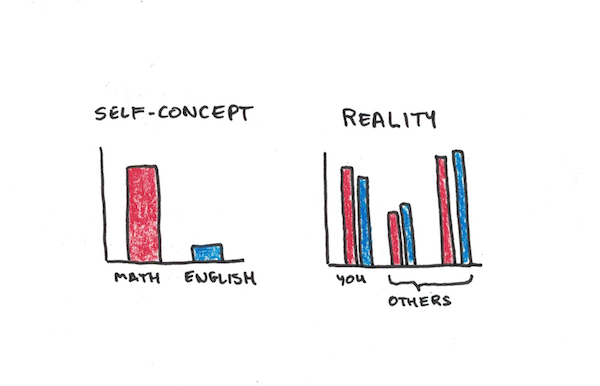
The internal/external model of self-concept becomes relevant here.112
If you are good at both math and language, but somewhat better at math, this can lead to a preferential self-concept as a “math” person. This may lead you to be less motivated to study English than someone who is an overall poorer student, but somewhat biased towards being good at English.
Summary
Your self-concept impacts motivation in many ways:
-
- Self-efficacy is essential for motivation. Direct experience and watching someone else perform do best, but arousal and persuasion are also factors.
-
- The Big Fish, Little Pond effect says that your self-concept will be indirectly based on your surrounding reference group. This, in turn, can impact your motivation.
-
- The internal-external model of self-concept suggests we also compare our strengths and weaknesses internally. Thus your motivation to do one thing might be hindered when you’re even better at something else.
My Thoughts on Applying this Research to Improve Your Life
Motivation is a huge topic and the science on many important questions is far from settled. Applying scientific research to practical scenarios is also fraught with complications. As experiments with intrinsic motivation have shown, naively applying theories tested on rats in a laboratory may not always have the intended effects on human beings in the real world.
Similarly cultural and sociological factors can make a huge difference in motivation beyond individual psychology. Even a simple question such as, “Do monetary bonuses improve work performance?” cannot be separated from the question of how such incentives are perceived and the meanings we attach to them in our culture.
While these difficulties make the practical implications of motivational research more nebulous, I do think there are many non-trivial takeaways from the research surveyed above:
1. Rewards and Punishments are at the Heart of Motivation.
The idea that all behavior can be explained through reinforcements now seems oversimplified. However, that this picture was compelling for so long speaks to the central role reinforcement plays in motivation. Especially when we consider that abstract things like autonomy may function as a need which reinforces behavior.
Theories like learned industriousness show how even a complex personality trait, such as the affinity for working hard on big ambitions, might be partly an outcome of subtle reward contingencies in the environment. Rewards to curiosity and learning can explain why we fall into some specialties and find other topics boring.

These rewards and punishments often assert themselves unconsciously. Thus we may not be able to consciously link our love of sports to early childhood experiences where they gave us a chance to connect with our peers and feel competent, but simply feel them now as a raw emotion.
2. Conscious Framing Greatly Impacts Our Drives.
The intentions we set impact our performance. The gaps in knowledge determine our curiosity. Whether an act is framed in terms of gains or losses, influences our appetite for risk. If we see a choice as controlled or self-initiated, our motivations change even if the situation hasn’t.
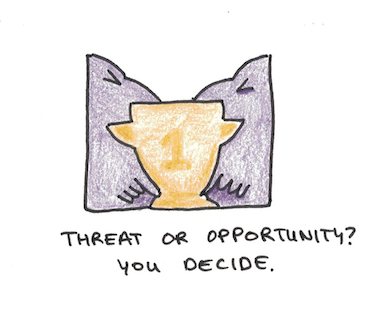
Even if the reinforcement contingencies happen at a level below our awareness for many tasks, conscious framing can make some decisions more salient, or change how we perceive the reward contingencies of particular tasks.
There are more degrees of freedom in how we frame situations than we typically realize. Yet the act of reframing is itself a motivational act. We may have the ability to reframe a situation, yet avoid the very act of reframing in the same way we avoid the action we’re trying to take.
3. There are Many Positive Feedback Loops.
The “high-performance cycle” as described by Locke and Latham, suggests that our achievement motivations may exhibit positive feedback. Set hard goals and commit to them, and our performance increases. This encourages setting harder goals and ambitions increase.

Self-efficacy, an essential concept in Bandura’s social-cognition theory of motivation, also creates a positive feedback loop. Feel like you can’t do anything and your motivation diminishes. This makes it harder to do the very things you believe you can’t do.
Learning results in positive feedback. The learning progress algorithm by Oudeyer et al. suggests that our exploration and curiosity-driven behaviors work on local features of our environment. We don’t do a global search of all possibilities (this is impossible) but move in the direction of greatest learning progress. This can result in some areas becoming off-limits (because they involve upfront work before progress can be realized) or accelerating (because as you learn, more learning is available).
Systems that exhibit positive feedback loops are unstable. They experience sensitivity to initial conditions and even chaotic outcomes. That our motivational systems are designed this way should recast the direction of our lives not as destinies, but as many branching possibilities.
4. Motivational Struggles are Caused By Competing Forces.
Motivation isn’t applied in isolation. You can’t think about your motivation to study, work hard or exercise, without also considering your motivational tendencies to do anything else.
Your motivation to act can have both approach and avoidance properties. You might be drawn to the idea of getting an A on your next paper, but pushed away by the thought of doing all that study. Our struggles to “motivate ourselves” are often about this implicit balance within the same task.
Similarly, motivations can compete from different sources. I might find it harder to read books in my spare time if I have easy access to Netflix. This isn’t because of a change in my desire to read books, but because watching television allows for a reward with less effort. The set of options considered matters greatly for motivation, and of course the set of options you consider is also controlled by conscious framing.
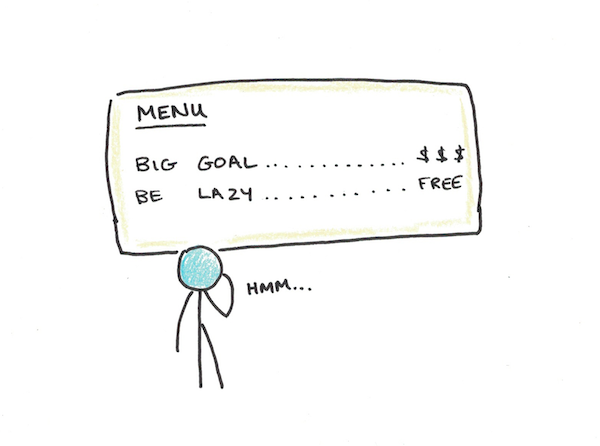
There may not be any tricks to decisively win the tug-of-war competing motivations play in our hearts, but we can often do subtle things that help tip the balance when the contest is close.
5. Many Sources of Motivation May Be Hidden From View.
A final takeaway from this research is the amount that our motivations are often invisible to us. In some cases this is simply because the hardware that runs our motivation is not expressible in the conscious mind. The selective strengthening of complex patterns of dopaminergic neurons synapsing on the basal ganglia is not something we have conscious access to.
In other cases, the motivations may be subtle and complex. Autonomy, competence and relatedness may be impacted in subtle ways by our environment. The goals we set may adjust our performance more than we realize. Our attention may emphasize some aspects of the situation and not others, leading to motivational effects we scarcely realize.
On the other hand, motivations may be strategically hidden from our consciousness. In our desire to impress others, win allies and present ourselves publicly, we may consciously downplay the internal motivations that truly decide our behavior. We may also be reluctant to recognize these hidden drives, as revealing the illusion would spoil the effect.
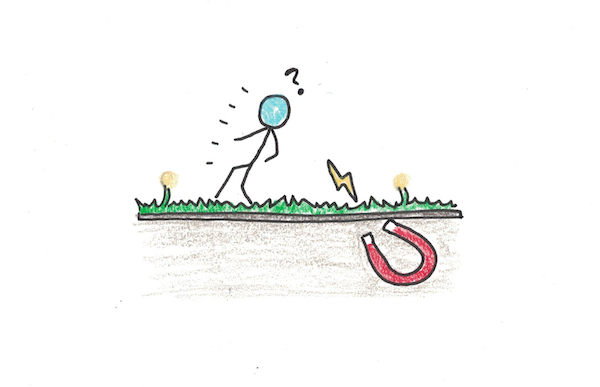
Knowing what your exact motivations are in any specific instance may be hard. But understanding how your motivation operates, in general, can suggest possible clues when you feel stuck with a problem. Are there reward contingencies you’re not aware of? Are you missing psychological needs, or framing the problem in a way that’s unhelpful? Do hidden motivations explain your difficulties?
Conclusion
Despite the already exhaustive length of this piece, I have definitely failed at the promise intended in the title. This isn’t a complete guide, as I’ve strategically left out much of the research on motivation. Some of this was intentional, as I was unconvinced by the research or persuaded by contrary viewpoints. In other cases this was simply necessary, as to include everything relevant to motivation couldn’t be done even in a guide ten times the length.
Still, I hope you’ve found this guide helpful in surveying a complex and interesting field. I also hope it provides some insight into the motivational challenges you face now and in the future.
If you’re interested in research-based guides like this one, I highly recommend checking out the guides I previously co-authored with Jakub Jilek:
References
Footnotes
- James, William, The Principles of Psychology Vol. 2, (New York City: Henry Holt & Co., 1890).
- Ibid, 522.
- Ibid, 524-525.
- Ibid, 525.
- Cox, Savannah. “What Sigmund Freud Got Wrong About Psychology (And Your Mother).” allthatisinteresting.com. https://allthatsinteresting.com/sigmund-freud-psychology (accessed October 5th, 2020).
- Wilson, Timothy D, Strangers to ourselves, (Cambridge (MA): Harvard University Press, 2004).
- Clark, Robert E. “The classical origins of Pavlov’s conditioning.” Integrative Physiological & Behavioral Science 39, no. 4 (2004): 279-294.
- Thorndike, Edward. “Animal Intelligence: Chapter V: LAWS AND HYPOTHESES FOR BEHAVIOR LAWS OF BEHAVIOR IN GENERAL.” Classics in the History of Psychology. https://psychclassics.yorku.ca/Thorndike/Animal/chap5.htm. (Accessed October 5th, 2020).
- Hull, Clark L. Principles of behavior. Vol. 422. New York: Appleton-century-crofts, 1943.
- Berridge, Kent C. “Motivation concepts in behavioral neuroscience.” Physiology & behavior 81, no. 2 (2004): 179-209.
- Weiner, B. (1972). Theories of motivation: From mechanism to cognition. Markham.
- Edwards, Ward. “The theory of decision making.” Psychological bulletin 51, no. 4 (1954): 380.
- Bindra, Dalbir. “How adaptive behavior is produced: A perceptual-motivational alternative to response-reinforcement.” Behavioral and brain sciences 1, no. 1 (1978): 41-91.
- Bindra, Dalbir. “A motivational view of learning, performance, and behavior modification.” Psychological review 81, no. 3 (1974): 199.
- Toates, Frederick, Motivational systems, (Cambridge (MA): Cambridge Univ. Press, 1986)
- Hebb, Donald Olding. The organization of behavior: a neuropsychological theory. J. Wiley; Chapman & Hall, 1949. 6-11
- Atkinson, John, David Birch, Introduction to Motivation, Second Edition, (New York, NY: D Van Nostrand Company, 1978), 6
- Ibid.
- Mandler, George. A history of modern experimental psychology: From James and Wundt to cognitive science. MIT press, 2011.
- Baddeley, Alan. Working memories: Postmen, divers and the cognitive revolution. Routledge, 2018.
- Skinner, B. F. “The Behavior of Organisms: An Experimental Analysis”, 1938 New York: Appleton-Century-Crofts
- “Operant Conditioning,” Boundless Psychology, https://courses.lumenlearning.com/boundless-psychology/chapter/operant-conditioning/ (Accessed: October 5th, 2020).
- Horsley, Rachel R., Matthew Osborne, Christine Norman, and Timothy Wells. “High-frequency gamblers show increased resistance to extinction following partial reinforcement.” Behavioural Brain Research 229, no. 2 (2012): 438-442.
- Hopson, John, “Behavioral Game Design,” Gamasutra, https://www.gamasutra.com/view/feature/131494/behavioral_game_design.php (Accessed: October 5th, 2020).
- Eisenberger, Robert. “Learned industriousness.” Psychological review 99, no. 2 (1992): 248.
- Mink, Jonathan W. “The basal ganglia: focused selection and inhibition of competing motor programs.” Progress in neurobiology 50, no. 4 (1996): 381-425.
- Zilles, Karl, and Katrin Amunts. “Centenary of Brodmann’s map—conception and fate.” Nature Reviews Neuroscience 11, no. 2 (2010): 139-145.
- Sereno, Martin I., Jörn Diedrichsen, Mohamed Tachrount, Guilherme Testa-Silva, Helen d’Arceuil, and Chris De Zeeuw. “The human cerebellum has almost 80% of the surface area of the neocortex.” Proceedings of the National Academy of Sciences 117, no. 32 (2020): 19538-19543.
- Rabey, J. M., and F. Hefti. “Neuromelanin synthesis in rat and human substantia nigra.” Journal of Neural Transmission-Parkinson’s Disease and Dementia Section 2, no. 1 (1990): 1-14.
- Kaji, Ryuji. “Basal ganglia as a sensory gating devise for motor control.” Journal of Medical Investigation 48, no. 3/4 (2001): 142-146.
- Middleton, Frank A., and Peter L. Strick. “Basal ganglia and cerebellar loops: motor and cognitive circuits.” Brain research reviews 31, no. 2-3 (2000): 236-250.
- Alexander, Garrett E., Michael D. Crutcher, and Mahlon R. DeLong. “Basal ganglia-thalamocortical circuits: parallel substrates for motor, oculomotor,“prefrontal” and “limbic” functions.” In Progress in brain research, vol. 85, pp. 119-146. Elsevier, 1991.
- Mink, Jonathan W. “The basal ganglia: focused selection and inhibition of competing motor programs.” Progress in neurobiology 50, no. 4 (1996): 381-425.
- Berridge, Kent C. “The debate over dopamine’s role in reward: the case for incentive salience.” Psychopharmacology 191, no. 3 (2007): 391-431.
- Mirenowicz, Jacques, and Wolfram Schultz. “Importance of unpredictability for reward responses in primate dopamine neurons.” Journal of neurophysiology 72, no. 2 (1994): 1024-1027.
- Murayama, Kou, “Neuroscientific and Psychological Approaches to Incentives” in The Cambridge Handbook of Motivation and Learning, ed. K. Ann Renninger and Suzanne E. Hidi, 141-162, Cambridge UK: Cambridge University Press, 2019.
- Pomara, Cristoforo, Tommaso Cassano, Stefano D’Errico, Stefania Bello, Antonino Davide Romano, I. Riezzo, and Gaetano Serviddio. “Data available on the extent of cocaine use and dependence: biochemistry, pharmacologic effects and global burden of disease of cocaine abusers.” Current medicinal chemistry 19, no. 33 (2012): 5647-5657.
- Solomon, Richard L., and John D. Corbit. “An opponent-process theory of motivation: I. Temporal dynamics of affect.” Psychological review 81, no. 2 (1974): 119.
- Grisel, Judith. Never enough: the neuroscience and experience of addiction. Anchor Books, 2020, 43.
- LeDoux, Joseph E. Anxious: Using the brain to understand and treat fear and anxiety. Penguin, 2015.
- Ibid, 35.
- Ibid, 285.
- Ibid, 75.
- Ryan, Richard M., Edward L. Deci, Self-Determination Theory, Guilleford Press, NY, 2017, p.vii
- Deci, Edward L. “Effects of externally mediated rewards on intrinsic motivation.” Journal of personality and Social Psychology 18, no. 1 (1971): 105.
- Deci, E. L., & Ryan, R. M. (1980a). The empirical exploration of intrinsic motivational processes. In L. Berkowitz (Ed.), Advances in experimental social psychology (Vol. 13, pp. 39–80). New York: Academic Press.
- Ryan, Richard M., Valerie Mims, and Richard Koestner. “Relation of reward contingency and interpersonal context to intrinsic motivation: A review and test using cognitive evaluation theory.” Journal of personality and Social Psychology 45, no. 4 (1983): 736.
- Ryan, Richard M., Edward L. Deci, Self-Determination Theory, Guilleford Press, NY, 2017, p.185
- Ibid, 63.
- Ibid, 179.
- Koestner, Richard, Gaëtan F. Losier, Robert J. Vallerand, and Donald Carducci. “Identified and introjected forms of political internalization: Extending self-determination theory.” Journal of personality and social psychology 70, no. 5 (1996): 1025.
- Ryan, Richard M., Edward L. Deci, Self-Determination Theory, Guilleford Press, NY, 2017, p. 206
- Ibid, 199.
- Ibid, 239.
- Ryan, Richard M., Valery I. Chirkov, Todd D. Little, Kennon M. Sheldon, Elena Timoshina, and Edward L. Deci. “The American dream in Russia: Extrinsic aspirations and well-being in two cultures.” Personality and social psychology bulletin 25, no. 12 (1999): 1509-1524.
- Landry, Anaïs Thibault, Julian Kindlein, Sarah-Geneviève Trépanier, Jacques Forest, Drea Zigarmi, Dobie Houson, and Felix C. Brodbeck. “Why individuals want money is what matters: Using self-determination theory to explain the differential relationship between motives for making money and employee psychological health.” Motivation and Emotion 40, no. 2 (2016): 226-242.
- Scott, John. “Rational choice theory.” Understanding contemporary society: Theories of the present 129 (2000): 671-85.
- Sundie, Jill M., Douglas T. Kenrick, Vladas Griskevicius, Joshua M. Tybur, Kathleen D. Vohs, and Daniel J. Beal. “Peacocks, Porsches, and Thorstein Veblen: Conspicuous consumption as a sexual signaling system.” Journal of personality and social psychology 100, no. 4 (2011): 664.
- Fitzgibbon, Claire D., and John H. Fanshawe. “Stotting in Thomson’s gazelles: an honest signal of condition.” Behavioral Ecology and Sociobiology 23, no. 2 (1988): 69-74.
- Simler, Kevin, and Robin Hanson. The elephant in the brain: Hidden motives in everyday life. Oxford University Press, 2017.
- Tversky, Amos, and Daniel Kahneman. “Advances in prospect theory: Cumulative representation of uncertainty.” Journal of Risk and uncertainty 5, no. 4 (1992): 297-323.
- Kahneman, Daniel. Thinking, fast and slow. Macmillan, 2011.
- Gigerenzer, Gerd, and Reinhard Selten, eds. Bounded rationality: The adaptive toolbox. MIT press, 2002.
- Cohen, Jonathan D., Samuel M. McClure, and Angela J. Yu. “Should I stay or should I go? How the human brain manages the trade-off between exploitation and exploration.” Philosophical Transactions of the Royal Society B: Biological Sciences 362, no. 1481 (2007): 933.
- Thaler, Richard H., and Cass R. Sunstein. Nudge: Improving decisions about health, wealth, and happiness. Penguin, 2009.
- Loewenstein, George. “The psychology of curiosity: A review and reinterpretation.” Psychological bulletin 116, no. 1 (1994): 75.
- Coie, John D. “An evaluation of the cross-situational stability of children’s curiosity 1.” Journal of Personality 42, no. 1 (1974): 93-116.
- Loewenstein, George. “The psychology of curiosity: A review and reinterpretation.” Psychological bulletin 116, no. 1 (1994): 75.
- Friston, Karl. “The free-energy principle: a unified brain theory?.” Nature reviews neuroscience 11, no. 2 (2010): 127-138.
- Oudeyer, Pierre-Yves, Frdric Kaplan, and Verena V. Hafner. “Intrinsic motivation systems for autonomous mental development.” IEEE transactions on evolutionary computation 11, no. 2 (2007): 265-286.
- Nett, Ulrike E., Thomas Goetz, and Lia M. Daniels. “What to do when feeling bored?: Students’ strategies for coping with boredom.” Learning and Individual Differences 20, no. 6 (2010): 626-638.
- Mugon, Jhotisha, James Danckert, and John D. Eastwood, “The Costs and Benefits of Boredom in the Classroom,” in The Cambridge Handbook of Motivation: Second Edition, (Cambridge UK: Cambridge University Press, 2019), 490
- Ellis, A., & Knaus, W. J. (1977). Overcoming procrastination. New York: Signet Books.
- Pychyl, Timothy A., Jonathan M. Lee, Rachelle Thibodeau, and Allan Blunt. “Five days of emotion: An experience sampling study of undergraduate student procrastination.” Journal of social Behavior and personality 15, no. 5 (2000): 239.
- Kasper, G. (2004, March 30). Tax procrastination: Survey finds 29% have yet to begin taxes. http://www.prweb.com/releases/2004/3/prweb114250.htm (Accessed: October 5th, 2020).
- Steel, Piers. “The nature of procrastination: A meta-analytic and theoretical review of quintessential self-regulatory failure.” Psychological bulletin 133, no. 1 (2007): 65.
- Procrastination Research Group, References for books, journal articles and theses about procrastination, http://www.carleton.ca/~tpychyl/prg/research/research_complete _biblio.html (Accessed: March 14th, 2006)
- Lay, Clarry H. “Trait procrastination and affective experiences: Describing past study behavior and its relation to agitation and dejection.” Motivation and Emotion 18, no. 3 (1994): 269-284.
- Steel, Piers. “The nature of procrastination: A meta-analytic and theoretical review of quintessential self-regulatory failure.” Psychological bulletin 133, no. 1 (2007): 65.
- Theogony and works and days. OUP Oxford, 2008.
- Steel, Piers. “The nature of procrastination: A meta-analytic and theoretical review of quintessential self-regulatory failure.” Psychological bulletin 133, no. 1 (2007): 65.
- Ibid.
- Ibid.
- Steel, Piers, and Cornelius J. König. “Integrating theories of motivation.” Academy of management review 31, no. 4 (2006): 889-913.
- Steel, Piers. “The nature of procrastination: A meta-analytic and theoretical review of quintessential self-regulatory failure.” Psychological bulletin 133, no. 1 (2007): 65.
- Latham, Gary P., and Gerard H. Seijts. “The effects of proximal and distal goals on performance on a moderately complex task.” Journal of Organizational Behavior: The International Journal of Industrial, Occupational and Organizational Psychology and Behavior 20, no. 4 (1999): 421-429.
- Bandura, Albert, W. H. Freeman, and Richard Lightsey. “Self-efficacy: The exercise of control.” (1999): 158-166.
- Ziesat Jr, Harold A., Ted L. Rosenthal, and Glenn M. White. “Behavioral self-control in treating procrastination of studying.” Psychological Reports 42, no. 1 (1978): 59-69.
- Weber, Max. “The Protestant Ethicand the Spirit of Capitalism.” New York: ScribnersWeberThe Protestant Ethic and the Spirit of Capitalism1958 (1905).
- Eisenberger, Robert. “Learned industriousness.” Psychological review 99, no. 2 (1992): 248.
- Hull, Clark L. Principles of Behavior. Vol. 422. New York: Appleton-century-crofts, 1943.
- Eisenberger, Robert, and Janet Mauriello Leonard. “Effects of conceptual task difficulty on generalized persistence.” The American Journal of Psychology (1980): 285-298.
- Locke, Edwin A. “Toward a theory of task motivation and incentives.” Organizational behavior and human performance 3, no. 2 (1968): 157-189.
- Locke, Edwin A., and Gary P. Latham. “Building a practically useful theory of goal setting and task motivation: A 35-year odyssey.” American psychologist 57, no. 9 (2002): 705.
- Locke, Edwin A., and Gary P. Latham. A theory of goal setting & task performance. Prentice-Hall, Inc, 1990.
- Atkinson, John W. “Towards experimental analysis of human motivation in terms of motives, expectancies, and incentives.” Motives in fantasy, action and society (1958): 288-305.
- Locke, Edwin A., and Gary P. Latham. “Building a practically useful theory of goal setting and task motivation: A 35-year odyssey.” American psychologist 57, no. 9 (2002): 705.
- Earley, P. Christopher, Terry Connolly, and Göran Ekegren. “Goals, strategy development, and task performance: Some limits on the efficacy of goal setting.” Journal of applied psychology 74, no. 1 (1989): 24.
- Kanfer, Ruth, and Phillip L. Ackerman. “Motivation and cognitive abilities: An integrative/aptitude-treatment interaction approach to skill acquisition.” Journal of applied psychology 74, no. 4 (1989): 657.
- Locke, Edwin A., and Gary P. Latham. “Building a practically useful theory of goal setting and task motivation: A 35-year odyssey.” American psychologist 57, no. 9 (2002): 705.
- Elliott, Elaine S., and Carol S. Dweck. “Goals: An approach to motivation and achievement.” Journal of personality and social psychology 54, no. 1 (1988): 5.
- Gollwitzer, Peter M., and Paschal Sheeran. “Implementation intentions and goal achievement: A meta-analysis of effects and processes.” Advances in experimental social psychology 38 (2006): 69-119.
- Gollwitzer, Peter M., and Veronika Brandstätter. “Implementation intentions and effective goal pursuit.” Journal of personality and social psychology 73, no. 1 (1997): 186.
- Bandura, Albert. “Social cognitive theory of personality.” Handbook of personality 2 (1999): 154-96.
- Henrich, Joseph. The secret of our success: How culture is driving human evolution, domesticating our species, and making us smarter. Princeton University Press, 2017.
- Bandura, Albert, W. H. Freeman, and Richard Lightsey. “Self-efficacy: The exercise of control.” (1999): 158-166.
- Bandura, Albert. “Self-efficacy.” The Corsini encyclopedia of psychology (2010): 1-3.
- Brown, Irvin, and Dillon K. Inouye. “Learned helplessness through modeling: The role of perceived similarity in competence.” Journal of personality and Social Psychology 36, no. 8 (1978): 900.
- Schunk, Dale H., and Antoinette R. Hanson. “Peer models: Influence on children’s self-efficacy and achievement.” Journal of educational psychology 77, no. 3 (1985): 313.
- Marsh, Herbert W., Marjorie Seaton, Ulrich Trautwein, Oliver Lüdtke, Kit-Tai Hau, Alison J. O’Mara, and Rhonda G. Craven. “The big-fish–little-pond-effect stands up to critical scrutiny: Implications for theory, methodology, and future research.” Educational psychology review 20, no. 3 (2008): 319-350.
- Marsh, Herbert W., Marjorie Seaton, Theresa Dicke, Philip D. Parker, Marcus S. Horwood. “The Centrality of Academic Self-Concept to Motivation and Learning” in The Cambridge Handbook of Motivation and Learning: Second Edition (Cambridge, UK: Cambridge University Press, 2019) 37-62
- Marsh, Herbert W. “Verbal and math self-concepts: An internal/external frame of reference model.” American educational research journal 23, no. 1 (1986): 129-149.

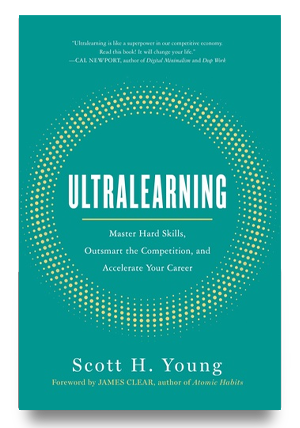
 I'm a Wall Street Journal bestselling author, podcast host, computer programmer and an avid reader. Since 2006, I've published weekly essays on this website to help people like you learn and think better. My work has been featured in The New York Times, BBC, TEDx, Pocket, Business Insider and more. I don't promise I have all the answers, just a place to start.
I'm a Wall Street Journal bestselling author, podcast host, computer programmer and an avid reader. Since 2006, I've published weekly essays on this website to help people like you learn and think better. My work has been featured in The New York Times, BBC, TEDx, Pocket, Business Insider and more. I don't promise I have all the answers, just a place to start.